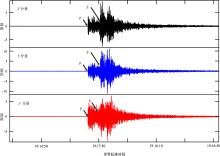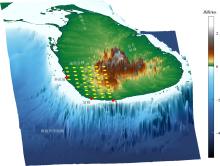| [1] |
刘宁, 莫利, 2015. “一带一路” 科技链: 斯里兰卡篇[J]. 科学新闻, 17(8): 94-96.
|
|
LIU NING, MO LI, 2015. “Onebelt, oneroad” technologychain: SriLanka[J]. Science News, 17(8): 94-96 (in Chinese).
|
| [2] |
彭朝勇, 杨建思, 薛兵, 等, 2014. 一体化低功耗宽频带数字地震仪研制[J]. 地震学报, 36(1): 146-155, 159.
|
|
PENG CHAOYONG, YANG JIANSI, XUE BING, et al, 2014. Development of a low-power broadband seismometer-integrated data logger[J]. Acta Seismologica Sinica, 36(1): 146-155, 159 (in Chinese with English abstract).
|
| [3] |
吴良士, 秦思婷, 2014. 斯里兰卡地质构造与区域成矿基本特征[J]. 矿床地质, 33(1): 233-236.
|
|
WU LIANGSHI, QIN SITING, 2014. Geological structure andbasic characteristics ofregional mineralization in SriLanka[J]. Mineral Deposits, 33(1): 233-236 (in Chinese).
|
| [4] |
杨冬冬, 邱海军, 胡胜, 等, 2020. “一带一路”地区地质灾害时空分布特征及防治对策[J]. 科技导报, 38(16): 45-52.
|
|
YANG DONGDONG, QIU HAIJUN, HU SHENG, et al, 2020. Temporal and spatial distributions of geo-hazards along the Belt and Road and policy recommendations for disaster prevention[J]. Science & Technology Review, 38(16): 45-52 (in Chinese with English abstract).
|
| [5] |
赵磊, 张艳斌, MALAVIARACHCHI SANJEEWA PRABHATH KUMARA, 等, 2021. 斯里兰卡地质演化研究的进展与评述: 岩石组合、变质演化及其与冈瓦纳大陆的关系[J]. 岩石学报, 37(5): 1287-1320.
|
|
ZHAO LEI, ZHANG YANBIN, KUMARA M S P, et al, 2021. A review and appraisal on the study progress of the geological evolution of Sri Lanka: Rock associations, metamorphism and their relations with Gondwana[J]. Acta Petrologica Sinica, 37(5): 1287-1320 (in Chinese with English abstract).
|
| [6] |
宗健业, 孙新蕾, 张鹏, 2020. 利用HVSR方法研究广州地区的场地效应及估算地震灾害特征[J]. 地震地质, 42(3): 628-639.
|
|
ZONG JIANYE, SUN XINLEI, ZHANG PENG, 2020. Site effect and earthquake disaster characteristics in Guangzhou area from horizontal-to-vertical spectral ratio (hvsr) method[J]. Seismology and Geology, 42(3): 628-639 (in Chinese with English abstract).
|
| [7] |
AMALAN K, RATNAYAKE A S, RATNAYAKE N P, et al, 2018. Influence of nearshore sediment dynamics on the distribution of heavy mineral placer deposits in Sri Lanka[J]. Environmental Earth Sciences, 77(21): 737.
|
| [8] |
ATHAUDA A M M G I U B, DHARMAPRIYA P L, MALAVIARACHCHI S P K, et al, 2024. Geochemical signatures of metapelites in the highland complex, Sri Lanka and Trivandrum Block, India: implications for provenance, nature and tectonic setting of their source protoliths[J]. Island Arc, 33(1): e12529.
|
| [9] |
CAO LINGMIN, HE XIAOBO, YUAN HUAIYU, et al, 2024. Upper-mantle seismic anisotropy in the southwestern North Island, New Zealand: Implications for regional upper-mantle and slab deformation[J]. Tectonophysics, 887: 230455.
|
| [10] |
COORAY P G, 1994. The Precambrian of Sri Lanka: a historical review[J]. Precambrian Research, 66(1/2/3/4): 3-18.
|
| [11] |
DREILING J, TILMANN F, YUAN XIAOHUI, et al, 2020. Crustal structure of Sri Lanka derived from joint inversion of surface wave dispersion and receiver functions using a Bayesian approach[J]. Journal of Geophysical Research: Solid Earth, 125(5): e2019JB018688.
|
| [12] |
DUSHYANTHA N P, HEMALAL P V A, JAYAWARDENA C L, et al, 2019. Application of geochemical techniques for prospecting unconventional phosphate sources: a case study of the lake sediments in Eppawala area Sri Lanka[J]. Journal of Geochemical Exploration, 201: 113-124.
|
| [13] |
FÄH D, KIND F, GIARDINI D, 2003. Inversion of local S-wave velocity structures from average H/V ratios, and their use for the estimation of site-effects[J]. Journal of Seismology, 7(4): 449-467.
|
| [14] |
GUNATILAKA A, 2007. Role of basin-wide landslides in the formation of extensive alluvial gemstone deposits in Sri Lanka[J]. Earth Surface Processes and Landforms, 32(12): 1863-1873.
|
| [15] |
GUNATILLAKE D, 2007. The 2004 Tsunami in Sri Lanka: Destruction and recovery[J]. Geography, 92(3): 285-293.
|
| [16] |
HÖLZL S, HOFMANN A W, TODT W, et al, 1994. U-Pb geochronology of the Sri Lankan basement[J]. Precambrian Research, 66(1/2/3/4): 123-149.
|
| [17] |
HOUSER C, HAMILTON S, 2009. Sensitivity of post-hurricane beach[J]. Earth Surface Process and Landforms, 34( March): 613-628.
|
| [18] |
KEHELPANNALA KVW, 2004. Arc Accretion Around Sri Lanka During the Assembly of Gondwana[J]. Gondwana Research, 7(4S): 41-46.
|
| [19] |
KRÖNER A, COORAY P G, VITANAGE P W, 1991. Lithotectonic subdivision of the Pre-cambrian basement in Sri Lanka[M]//KRÖNER A, The crystalline crust of Sri Lanka, Part Ⅰ. Summary of research of the German-Sri Lankan consortium. Geological Survey Department, Sri Lanka: 5-21.
|
| [20] |
KRÖNER A, WILLIAMS I S, COMPSTON W, et al, 1987. Zircon ion microprobe dating of high-grade rocks in Sri Lanka[J]. The Journal of Geology, 95(6): 775-791.
|
| [21] |
LI CHENG, YAO HUAJIAN, FANG HONGJIAN, et al, 2016. 3D near-surface shear-wave velocity structure from ambient-noise tomography and borehole data in the Hefei urban area, China[J]. Seismological Research Letters, 87(4): 882-892.
|
| [22] |
MASCANDOLA C, MASSA M, BARANI S, et al, 2017. Long-period amplification in deep alluvial basins and consequences for site-specific probabilistic seismic-hazard analysis: an example from the Po plain (northern Italy)[J]. Bulletin of the Seismological Society of America, 107(2): 770-786.
|
| [23] |
MATHAVAN V, PRAME W K B N, COORAY P G, 1999. Geology of the high grade Proterozoic terrains of Sri Lanka, and the assembly of Gondwana: an update on recent developments[J]. Gondwana Research, 2(2): 237-250.
|
| [24] |
MILISENDA C C, LIEWA T C, HOFMANNA A W, et al, 1988. Isotopic mapping of age provinces in Precambrian high-grade terrains: Sri Lanka[J]. The Journal of Geology, 96(5): 608-615.
|
| [25] |
MILISENDA C C, LIEWA T C, HOFMANNA A W, et al, 1994. Nd isotopic mapping of the Sri Lanka basement: update, and additional constraints from Sr isotopes[J]. Precambrian Research, 66(1/2/3/4): 95-110.
|
| [26] |
PAROLAI S, 2002. New relationships between vs, thickness of sediments, and resonance frequency calculated by the H/V ratio of seismic noise for the cologne area (Germany)[J]. Bulletin of the Seismological Society of America, 92(6): 2521-2527.
|
| [27] |
PICOZZI M, PAROLAI S, BINDI D, et al, 2009. Characterization of shallow geology by high-frequency seismic noise tomography[J]. Geophysical Journal International, 176(1): 164-174.
|
| [28] |
SASSA K, MATSUNAMI K, DOAN L, et al, 2023. The 2023. 4. 24 Hambantota-offshore earthquake and microearthquakes in Sri Lanka and the landslide risk evaluation in a nearby slope by post-rainfall earthquakes[J]. Landslides, 20(8): 1771-1779.
|
| [29] |
SUMANARATHNA A R, 2018. Geology of Sri Lanka: a journey through ancient landscapes and unique geological features[J]. Journal of Eco Astronomy, 01(01): 60-89.
|
| [30] |
VANACKER V, VON BLANCKENBURG F, HEWAWASAM T, et al, 2007. Constraining landscape development of the Sri Lankan escarpment with cosmogenic nuclides in river sediment[J]. Earth and Planetary Science Letters, 253(3/4): 402-414.
|
| [31] |
WANG WEI, CAWOOD P A, PANDIT M K, et al, 2019. No collision between Eastern and Western Gondwana at their northern extent[J]. Geology, 47(4): 308-312.
|
| [32] |
WICKRAMASINGHE W A G K, MADUGALLA T B N S, ATHURUPANA B, et al, 2024. An unusual occurrence of carbonatites derived from the crust in the UHT granulite facies metamorphic terrain of Sri Lanka[J]. Precambrian Research, 410: 107502.
|
| [33] |
ZHAO LEI, LAKSHITHA DHARMAPRIYA P, ZHANG YANBIN, et al, 2023. Expanding azania at the heart of Gondwana: terrane correlation from southern India to Sri Lanka[J]. Precambrian Research, 395: 107149.
|
 ), SENANAYAKA Dasun1,2, CHENG Jinhui1(
), SENANAYAKA Dasun1,2, CHENG Jinhui1( ), ZHOU Yong1, CAO Lingmin1, ZHAO Lei4, LUO Yao3, ZHANG Zhenqiu3, PAN Gang3, THALDENA Nilmini5, ZHANG Jiazheng1,2, ZHANG Yayun1, XU Min1,2
), ZHOU Yong1, CAO Lingmin1, ZHAO Lei4, LUO Yao3, ZHANG Zhenqiu3, PAN Gang3, THALDENA Nilmini5, ZHANG Jiazheng1,2, ZHANG Yayun1, XU Min1,2















